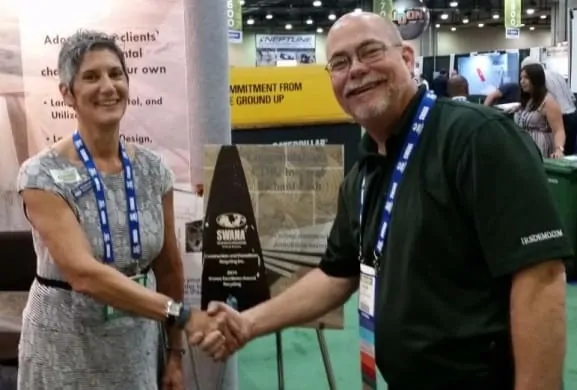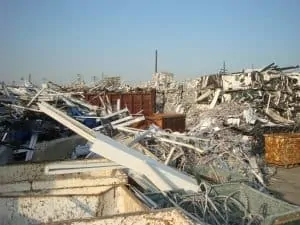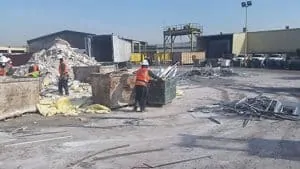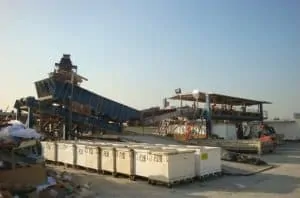


SCS is proud to publish this article highlighting CDR’s accomplishments achieved through financial planning and innovative thinking. The article was written by SCS staff members with information, data, and photos from Richard Ludt, a LEED AP, and the Director of Environmental at Interior Removal Specialist, Inc.(IRS), SWANA, and the U.S. Green Building Council.
CDR is the only construction and demolition (C&D) recycling facility in the United States that solely processes commercial interior debris as a waste stream unto itself. Concerned about the sheer volume of waste being landfilled and believing that there was a market for a large portion of the materials and debris removed from interior demolition projects, IRS founded CDR in 2003 to achieve actual, quantifiable diversion from landfills of commercial interior C&D debris.
The CDR facility is permitted to receive 3,000 tons per day of materials. It processes materials from IRS demolition operations, as well as C&D debris generated by others. The facility has a high landfill diversion rate, and over the past several years has diverted between 80 to 90% of all incoming materials for reuse and recycling.

CDR realized that the waste stream from commercial interior projects differed significantly from materials targeted by traditional C&D recycling facilities. Traditional facilities target only the most valuable materials such as metals, concrete, asphalt, and dimensional lumber. These materials constitute nearly 80% of all inbound tonnage from structural demolition projects but account for only about 35% of the commercial interior debris. CDR recycles these four materials, and also pioneered diversion of materials not captured at standard C&D facilities such as gypsum drywall, carpeting, acoustic ceiling tiles, cardboard, manufactured lumber, and other construction project materials.
The staff of CDR jumped into the recycling world with completely open minds; they approached diversion and recycling with a fresh perspective and looked for places to recycle materials that other facilities had not considered. The drywall, carpet, and ceiling tile that they recover has long been regarded by many to be residual debris with no commercial or reuse value, and that accepted notion has limited the amount of time and energy that other companies put into finding markets for these materials. Because CDR had no preconceptions about what could and could not be recycled, they looked for outlets, and eventually found them – many of them.
The CDR facility was designed and built to maximize the diversion of these materials using a labor-intensive hand-sorting line to capture every bit of material that can be recycled, reused, or repurposed instead of landfilled. For example, used cabinetry, furniture, and intact carpet and ceiling tiles are donated to numerous charities, and gypsum drywall is reused as a soil amendment by farmers in Northern California. In 2015, CDR processed 57,000 tons of commercial interior C&D debris and diverted 52,000 tons from landfills.
Finding ways to increase diversion of interior C&D was also a good way to satisfy expanding LEED and Green Building requirements in California. The importance of this issue came to light when the City of Santa Monica, CA, became one of the first cities to require proof of diversion in excess of 50% for construction and renovation jobs within the city limits.
Another valuable service that CDR provides is their diligent work keeping toxic materials out of landfills to minimize the risk of environmental damage. Basing their diversion goals not just on profitability, but on decreasing toxicity has been one of the organization’s missions since the beginning.
Helping the community has always been important to CDR. Through donations, diversion, and community education, CDR supports countless charities and non-profit organizations to assist those in need. CDR has partnerships with hundreds of local and international non-profit agencies, making it possible for the facility to donate approximately 600 tons of material for re-use every year; totaling 12,000 tons to date. No non-profit is turned away, and CDR is constantly looking for more recipients so that they can continue to receive these materials and keep them out of landfills. The cost savings of the donated materials enabled these non-profits to further their good works and reach out to a growing population of people in need.

CDR works in close collaboration with Homeboy Industries, an organization that provides hope, training, and support to formerly gang-involved individuals and previously incarcerated men and women, employing many graduates of the Homeboy Industries program, who have proven to be some of their best workers. In fact, many of the Homeboys have moved up to management positions. Additional labor for the yard has been hired through Teen Challenge International where teenagers and young adults who are overcoming addiction issues can find help and stability.

CDR has created dozens of green jobs in their donation and diversion program, as well as new markets for traditionally ignored materials. The non-traditional materials now being recycled by CDR are creating or sustaining an unknown number of green jobs in other companies upstream.
CDR sponsors South Gate Earth Day activities and participates in Earth Day activities sponsored by surrounding cities and local businesses. These events encourage participants to become stewards of the environment. CDR has also provided free e-waste collection for local businesses and has assisted the City of South Gate in the clean-up of an old courthouse that the city is converting into a youth center.
CDR promotes education whenever possible. They host tours of their facility for local building owners, contractors, city staff, architects, and students of local high schools, colleges, and architectural schools. These tours increase awareness of the environmental impacts of failing to divert the materials that CDR processes, and they highlight the environmental and economic benefits of diverting as much of this material as possible. CDR staff regularly presents at industry conferences and seminars in order to spread knowledge about diversion best practices and opportunities.
CDR continues to look for more opportunities to recycle, re-use, and divert materials received from interior construction and demolition projects. The firm also encourages other recycling facilities to follow their model and begin searching for opportunities to divert and recycle more materials and reduce the amount of debris that goes into landfills. As CDR continues expanding its donation program, the facility also continues to grow and expand; recently adding green waste processing and transfer to its operations in order to handle the material collected from residential curbside collection programs, and commercial landscapers. The facility is looking ahead into the future as well and is evaluating the potential to host a technology that can process waste into renewable energy or other beneficial uses.
Leading by example, CDR is far from a standard recycling facility, but they are convinced that similar diversion rates are attainable by almost every other C&D recycling facility in the country. The only difference between CDR and other facilities is that CDR deliberately decided to target the less traditional materials, which are often less valuable, more difficult to recycle, and more toxic, but the impact of diverting and recycling these materials can be huge.
The CDR facility operates on hand-sorting and a rudimentary sorting line. It relies extensively on highly-trained laborers who embrace the company’s philosophy of diverting the greatest volume of material possible. Nearly any existing facility could add the less traditional materials to their current C&D program through simple changes to their operating procedures. A facility could divert non-traditional materials with their sorting system by establishing two separate piles of debris for sorting in two separate shifts. The traditional materials generated from full building construction and demolition could be sorted during one shift and the less-commonly diverted materials from commercial interior projects could be sorted into another pile. By processing this material as its own waste stream, these facilities should be able to achieve huge diversion numbers without having to invest in additional equipment or infrastructure.
CDR’s reuse program would be more challenging for other facilities to duplicate, but it can be done. Most other recycling facilities do not focus on salvaging usable items, so changes in operating procedures are necessary. In addition, C&D recycling facilities typically do not have on-site warehousing for the reusable items; whereas, CDR has a 130,000 square foot warehouse where it stores materials awaiting donation. Finally, other recycling facilities could partner with community organizations or non-profit agencies to manage recovered items.
CDR is amending its Solid Waste Permit to accept Municipal Solid Waste (MSW) in order to increase the amount and types of materials they can divert, helping the City of Los Angeles and the State of California reach their diversion goals. With this addition to the permit, CDR plans to construct a 52,000 square foot MSW Material Recovery Facility to begin accepting trash from the City of Los Angeles. In addition to the enormous environmental benefits, this should create several hundred jobs during construction of the MRF, and more than 100 permanent jobs in the green sector when the new facility is completed. This new facility will help the City of Los Angeles, as well as the State of California, reach their 2020 goals of achieving 75% diversion from landfills.
About Richard Ludt
Richard Ludt, a LEED Accredited Professional, is the Director of Environmental at Interior Removal Specialist, Inc. Richard is responsible for complying with California’s heavily regulated solid waste ordinances and coordinates the extensive efforts involved for the recycling of the various construction debris obtained from tenant improvement demolition projects, including E-Waste, Acoustic Ceiling Tiles, carpeting, and over 22,000,000 pounds of drywall.
Working with dozens of nonprofit agencies Richard has overseen the donation of furniture, cabinetry, and other materials from demolition jobs in Southern California that would have otherwise gone to landfill. The acoustic ceiling tile program that Richard spearheaded was a major contributing factor to Interior Removal Specialist, Inc. receiving the Governors Environmental and Economic Leadership Award in 2005 and recently the 2016 Small Business of the Year for California’s 63rd Assembly District. CDR received the 2014 Bronze Award for Recycling from the Solid Waste Association of America (SWANA) and has been notified SWANA will honor the company with a second Bronze Award for Special Waste in 2016.
CDR’s website provides a wealth of information about C&D recycling in general and their novel approach to increasing awareness as well as recycling, diversion, and donation rates.
Read more about permitting C&D facilities and remember that sustainable programs use feasibility, financial, and solid waste planning.